Not only because I think he resembles an impudent rascally adorable little boy — but because that’s actually his name!

I can hear you thinking, What is she talking about? That’s a pansy!
Well, yes and no.
Johnny Jump-ups are in the same family as pansies, the Viola family. But they’re wilder, smaller, are exceedingly hardy and they sprout up quickly, hence their name, Jump-ups. I never planted the Johnny Jump-ups that flourish in spring in my front garden. They were just there, and from time to time, more volunteers join them:

This is a whole bunch of the kids. They’re bright and brash and bring a smile to my face whatever mood I was in before I saw them. Cute little kids, shining in the grass. Boys just wanna have fun!
(Johnny Jump-ups, Viola tricolor, have also been called by other names, like heart’s ease, heart’s delight, tickle-my-fancy, Jack-jump-up-and-kiss-me, come-and-cuddle-me, three faces in a hood, or love-in-idleness. In past times they were used in herbal medicine for epilepsy, asthma, skin diseases and eczema. V. tricolor has a folk history of helping respiratory problems such as bronchitis, asthma, and cold symptoms. Its expectorant properties prompted its use in the treatment of chest complaints such as bronchitis and whooping cough, and as a diuretic, it has been used in treating rheumatism and cystitis.)
Compared to the wildly flourishing Johnny Jump-ups, the cultivated garden pansy is a whole ‘nother matter.

Altogether larger, more imposing and stately, its face rewards pondering, responding to. Which may reflect the origins of its name, from the French verb penser, to think, with its accompanying noun, pensées, thoughts. “There’s pansies, that’s for thoughts,” says tragic Ophelia in her madness (in Shakespeare’s Hamlet, where, we might argue, she is the victim of Hamlet’s over-thinking).
There’s nothing mad about these pansy faces, however:

Calm beauties, each of them.


How delightful that these magical floral garden nymphs spring up from time to time for your delight. Oh I find this so marvelous!!! We have some delightful surprises that appear from time to time, but none as beautiful as these!
LikeLike
And even more delightful that they ask nothing of me but to admire them!
I love wildflowers for that reason, they are pure gift.
Thanks for your visits, Emil. They always strengthen me, just as the flowers do.
LikeLike
I prefer the wild ones 🙂
LikeLike
I like ’em all — but the full heat of summer is taking a toll on them, they’re really delights of spring.
LikeLike
Love the descriptive terminology :). And that fabulous depth of colour in both the ‘jump-ups’ and the cultivated.
LikeLike
Color is NOT enhanced in any way! That’s the way Ma Nature made ’em.
🙂
LikeLike
Ma N certainly has an eye for fabulous ‘couture’ 🙂
LikeLike
Indeed she does!
🙂
LikeLike
Your Johnny strongly reminds me of horned viola (viola cornuta). Not saying he is! They just bear a strong resemblence. Viola tricolor – aka Johnny – is the progenitor of the cultivated pansy. The horned viola is found in the wild, too: native to the Pyrenees and the Cordillera Cantábrica of northern Spain at altitude of 1,000–2,300 metres (3,300–7,500 ft) (source for all information: Wikipedia). The colour shown on Wikipedia for the horned pansy is not the one that is mainly bred and sold – the wild variety is truly a violet 😉 – they breed them in the colour your Johnny shows up on your doorstep.
LikeLike
That is all so interesting, Fran!
I wonder if one would encounter V. cornuta walking the Way to Santiago? Perhaps too high?
When you say, aptly, that V. tricolor is the progenitor of the cultivated pansy, does that say yet again — The child is father to the man? 😉
(I wish I had German one-quarter the way you have English!
LikeLike
Ooops – I borrowed the knowledge (and the word progenitor, too) from Wikipedia … I am not an expert on flowers. I even thought from your photos that viola tricolore and horned violet were the same … unless I checked the latin name for horned violet.
So if I sounded competent in my comment – forget it, as soon as possible. I am not. But I am good at passing the knowledge of others on … Never wanted to come over as if those were my words (hence the mention of Wikipedia as source).
I learned today four things. First, most important – to make it even more explicit that a text is not my doing but a quotation. Second, the german word for progenitor (Urahn, Stammvater). Third, what looks like a horned violet must not naturally be one. And last that our garden pansy is stemming from a flower that is known as viola tricolore. That is pretty much for one blog post mentioning the joy about some wild flowers. Thank you for the opportunity to broaden my knowledge.
LikeLike
I did some poking around on the ‘Net after I got this interesting comment from you. The images of horned violet (V. Cornuta) look like our “regular” pansies, the cultivated kind that we buy, the second kind I show in the post. The tricolors are a lot smaller and, well, “wilder,” like wildflowers.
You did make it clear that you were quoting from Wikipedia! It’s where I almost always begin the hunt for information —
I like the word Stammvater because I can recognize the “father” part in it!
The whole relationship among pansies, violas, and violets seems pretty complex. I love violets as well as pansies, and will most likely be posting some photos of them also in a little while. They’re poetic, in English — “shrinking violets”, for example — and associated with modesty.
We’re both of us allowed a lot of leeway when it comes to botany and pansies — it seems there are over 500 species in the world!
🙂
LikeLike
Horned violets are not as big as pansies. A friend of mine bought some for decoration on her birthday (late April) – and they are way smaller than a pansy.
LikeLike
Better Homes & Gardens magazine here has this to say: “Pansies are viola hybrids, officially known as Viola x wittrockiana, with a complex ancestry that includes several species.”
So we’re both correct, it’s complex. And we probably can say with accuracy, The one big Viola family contains a whole bunch of related clans, all pretty terrific!
LikeLike
A bunch of cute kids in old fashioned sailor style outfits!
LikeLike
A delightful comparison! Thank you 🙂
LikeLike
They are beautiful, and so much colour!
LikeLike
Thanks, Barb! In pastel New England, we take our color where we find it! Compared to you — small quantities indeed.
LikeLike
How wonderful to have those come up and flourish without any effort! They are just beautiful.
LikeLike
Really high on the cheerfulness factor, a real blessing!
LikeLike
V. triolor is the provincial flower, where I come from in Sweden. The colouring is slightly different from Johnny’s, with less yellow and more blue. They have two names in Swedish; ‘Night and Day’ or ‘Stepmother’s viola’.
I love wildflowers!
LikeLike
Me, too! No work is GOOD. Just appreciating.
The names are really something, aren’t they!
Why Night and Day? And really really why Stepmother’s viola!!!!!
I suspect the answer is, Why not?
🙂
LikeLike
Styvmorsviol, I don’t know. Natt och Dag refers to the dark blue as night and the yellow; day..sun.
LikeLike
Well, that’s logical enough when you translate it.
But the stepmother, now that’s trickier. When you go to Sweden in August, that’ll be your assignment, to find out about the stepmoms and the little violas.
😉
LikeLike
Yes! 🙂 I will find out.
We have an indoor house-plant called ‘Mother-in-Law’s tongue’ also, but that one I think is something similar here.. they look really sharp-tongued.
LikeLike
We also have a Mother-in-law’s tongue or something like that, probably the same as yours. REALLY UGLY, they are. It’s closely related to — are you ready for this?— the Snake Plant.
Both of them are considered valuable (?) house plants because they’re so tough to kill!
LikeLike
The Johnny Jump Up’s are beautiful. I only know of the cultivated violets, we had large beds full of their smiling faces in our plantation gardens.
LikeLike
Since I began this post I discovered the close resemblance between pansies and sweet violets, all in the Viola family.
I love big-faced hybrid pansies of various colors, and I love purple violets as well. One family though all of them are, I do think their personalities are different. (as, “smiling faces” that you comment on vs shrinking violets hiding their sweet faces in their foliage)
Maybe I should do the modest, diffident (but also beautiful) sweet violets next — I’d been thinking of something totally different, like hibiscus!
🙂 We’ll see —
LikeLike
Pansies and Violets are wonderfully beautiful flowers. We have wild violets hiding away in our garden – a legacy from a day out in the 1950’s when my mother brought some home (an illegal act now but not then). There is a ‘Johnny Jump-Up’ growing at the base of the wall in the front where I park the car.
LikeLike
To me there’s something really personal about violets and jump-ups, and your comment confirms that!
What’s illegal now about the wild violets? They spread too readily? Or you’re not supposed to take them away from where they are in the wild?
LikeLike
You’re not allowed to take plants from the wild and that includes taking picking flowers to make pressings. The modern advice is to collect them photographically – which just about anyone with a mobile phone can do 🙂
LikeLike
That makes sense!
🙂
LikeLike
Hi Johnny! Like “Samt und Seide” although wild! Wonderful! Love them!
***karin
LikeLike
Hmm. The television program?
Or silk and satin?
That’s as far as Mr. Google has got me!
😉
LikeLike